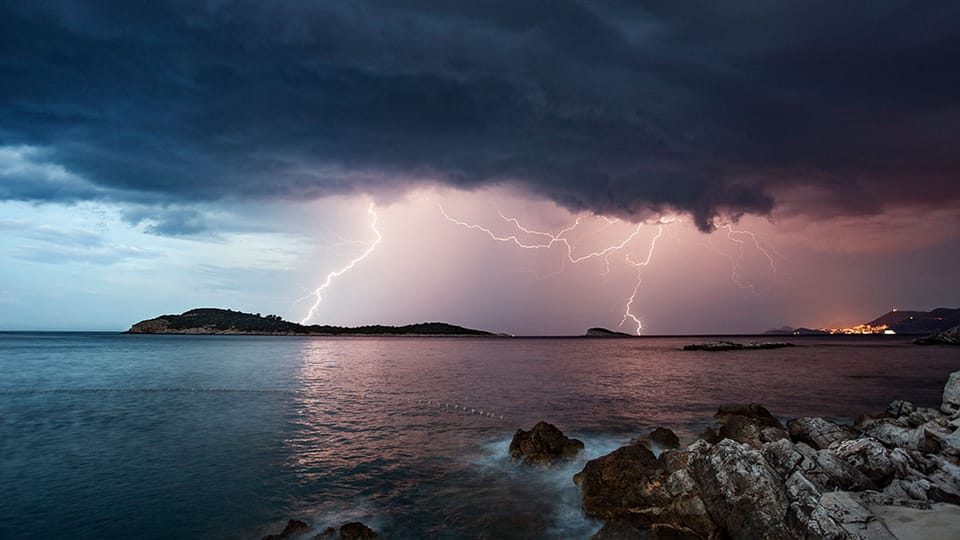A Day Out At Sea

Today was the boat party we had been looking forward to for months. It was also a day with rainstorm (>30mm/hr) and thunderstorm warning. Today I learned a lot about lightning, jellyfish, but most importantly I flagged an area for personal improvement. Let’s start with the factual stuff.
Lightning
- Thunderstorms are characterized by lightning and thunder
- In an unstable and moist atmosphere, water droplets and ice pellets in the cloud will become electrically charged and when it reaches a breakdown value, lightning discharges take place between clouds or between cloud and the earth's surface
- The sound of thunder is the explosive expansion of the surrounding air

- In the US between 2006-2015, there were 71 water-related deaths from lightning strokes (20% of people in boats, 8% of swimmers, but relative number of people involved in each activity unknown). Bottom line is - you can definitely be killed by lightning while on or in the water.
- 1 out of 1000 boats get struck by lightning in any given year in the US (Boats U.S.)
- Lightning often strikes the tallest thing in its vicinity. If you are swimming, your head could potentially be the highest point in the area.
- Death from lightning strike while swimming has happened in Hong Kong in 2021 in Clear Water Bay country park
- Conventional lightning protection system on boats consist of a lightning road above the boat connected to an underwater metal ground plate attached to the hull and other large metal objects.

Jellyfish
- Jellyfish are not great swimmers, and are more likely to be near the shore after heavy rain or windy weather
- Jellyfish sting by using nematocysts (stinging cells) within structures called cnidocytes along their tentacles. Nematocysts consist of tubules that inject venom into their prey, and the length of the tubule can determine the amount of pain caused
- Treatment depends on the type of jellyfish but in general
- Rinse with seawater (not fresh water) and soak in hot (but not scalding) water ~20 min (may deactivate venom for certain types of nematocysts)
- Remove tentacles (tweezers or credit card if needed; wear gloves)
- Pain relievers, antihistamines and steroid cream
- Anti-venoms for nasty stings but unlikely to need medical attention unless severe allergic reaction or anaphylaxis
- Do not pee on it, do not touch the tentacles or spines with bare hands, do not cover wound
- Usually improves within hours
- Symptoms: pain, rash, welts (in my case tingling sensation)

- Wet suits or jellyfish repellent can protect you from jellyfish
- Jellyfish repellent works by tricking them into thinking you are also a jellyfish so they don’t sting you in defence; it also has an extract of plankton that helps to block the creature’s sting sensor; it can protect you from jellyfish larvae too

- Physical contact between human skin and jellyfish tentacles activates the stinging cells

Room for Improvement
In social events like these, I notice that there were people that I feel particularly comfortable around, people who feel kind and genuine. And it got me thinking about what kind of vibe I give off - am I quiet and mysterious, goofy and a bit crazy, or stubborn and opinionated?
Upon doing some reflection, I have come to realize that I can be a bit too blunt at times and might not have considered how my words or reactions can make others feel. The takeaway from today in this regard is that there is room for improvement in terms of the delivery of my messages. It’s not about wanting to be liked or wrapping up harsh comments in a pretty package, but about how to effectively deliver the message with the aim of a common understanding.
The backstory is that I was worried about the risks of proceeding with the boat trip given the weather conditions, mainly I was worried about being stuck by lightning while out at sea. I noticed that I used a more urgent pressing tone and a louder voice in an attempt to get my message across. Initially I thought it was out of fear for my own safety, but that wasn’t it because I could have easily opted out of the trip while they went on ahead. It was more of an urgency because I wasn’t sure if everyone really understood the risk, and it was important to me for everyone to understand the risks and to make an informed decision for themselves about whether to go ahead with the boat trip.
I think the intention was good, but I also recognize that the tone of voice and the bluntness of the delivery might have actually had a negative impact on the delivery of the message. So moving forward I would like to notice when I am worried, scared or stressed and to take a moment to think about what I want to say and how to say it before opening my mouth. Because at the end of the day it’s not about forcing my thoughts onto other people, but rather the sharing of information that I think would be helpful and useful.
Thank you to everyone for being so kind and forgiving, and here’s to continuing to grow and being a better version of me.






Member discussion